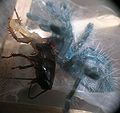- Antilles pinktoe
-
Antilles Pink Toed Tarantula 
Avicularia versicolor Scientific classification Kingdom: Animalia Phylum: Arthropoda Class: Arachnida Order: Araneae Suborder: Mygalomorphae Family: Theraphosidae Genus: Avicularia Species: A. versicolor Binomial name Avicularia versicolor
(Walckenaer, 1837)Synonyms Aranea hirtipes
Mygale hirtipes
Mygale versicolorThe Antilles pinktoe tarantula (Avicularia versicolor), also known as the Martinique Red Tree Spider or the Martinique Pinktoe, is native to Guadeloupe and Martinique in the Caribbean Sea, but is a popular spider pet due to its docile character and unique coloration.
Antilles pinktoe tarantulas are arboreal (tree-dwelling). They spin elaborate funnel webs in which they spend most of their time. In captivity, cage height is much more important than floor space. Decor consists of tree branches or cork pieces to which the spider can attach its web.
Spiderlings of A. versicolor are bright blue, with a black treetrunk pattern on the abdomen. As they grow, they gradually lose the blue coloration and their carapace turns green, their abdomen red, their legs green with purple hairs and pink tarsi. They are a more colorful version of their cousin, the Pinktoe tarantula. On average, males are slightly more brightly colored than females. Like most tarantulas, males stay much smaller than females- especially in the abdomen.
Contents
Caring for Antilles Pink Toe
This tarantula requires a delicate balance of good ventilation and high humidity. A terrarium with a screen top and daily misting achieves that balance. The Antilles do well at a temperature of between 75 degrees F, but will tolerate temperatures ranging from 60 to 82 degrees F. They enjoy high humidity- ideally between 70 and 80 percent RH
Feeding
The Antilles pinktoe is an aggressive feeder, and will eat anything from crickets, grasshoppers, cockroaches, beetles, moths, and other flying insects, to anole lizards. They will also take mealworms and moth larvae, but these have to be given sparingly due to their fat percentage and the calcium-phosphor proportions.
Temperament
Antilles pinktoes are naturally docile, although they are quick and can jump up to 30 cm far or high. They are the sole genus possessing type II urticating hairs for defense, but unlike terrestrial new world tarantulas they generally do not kick them, chosing to instead press them against the perceived threat when used. Bites from this type of spider are rare, if provoked it flees. Bites are not dangerous; comparable to a wasp sting.
Photos
External links
- Caring for Avicularia versicolor
- Tarantulas of the Genus Avicularia
- Photos of Avicularia versicolor and other 13 Avicularia species in gallery of tarantulas.
- Antilles Pink Toed Tarantula - description

This spider–related article is a stub. You can help Wikipedia by expanding it.



